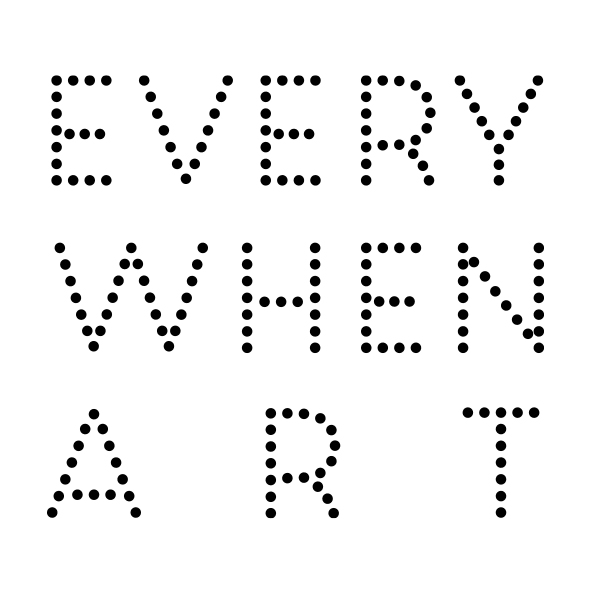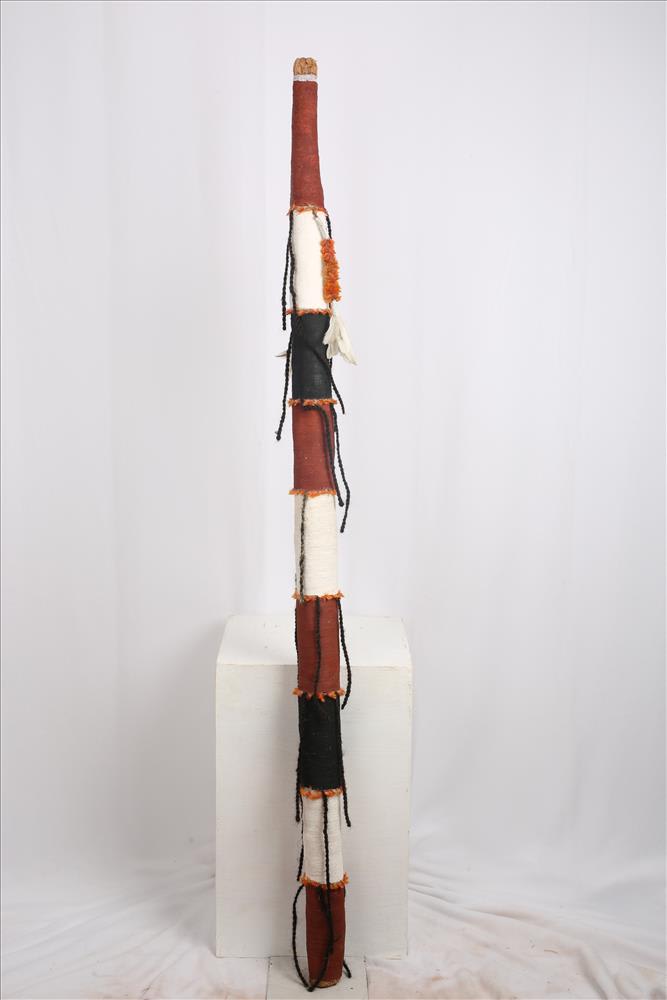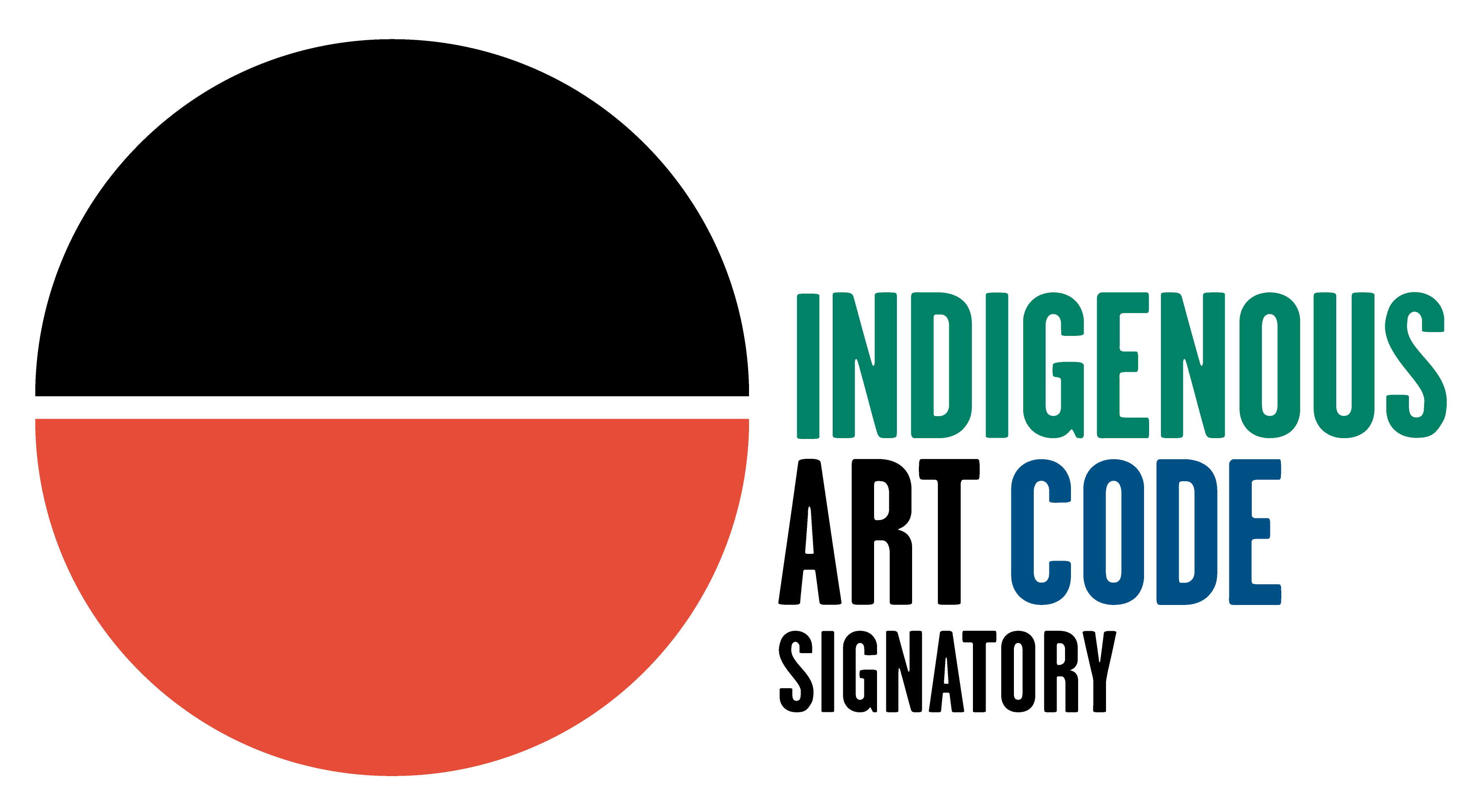Jack Nawilil Rembarrnga, Mayali, b. 1/1/1945
71 1/4 x 3 1/2 x 3 1/2 in
Transcribed by Murray Garde and Margaret Carew on 2 & 5 December 2017. Notes by Margaret Carew on 5 Dec 2017
Note:
The site Jack refers to as Koenoedjangka is in the Rembarrnga language.
The ‘oe’ vowel sounds like the ‘ur’ in English ‘fur’. As this vowel
does not exist in neighbouring languages, it is usually converted to an
‘i’ as Kinidjangka by Kuninjku and Burarra speakers. I have used that
spelling also in the English translation but retained Koenoedjangka in
the transcription of Jack’s speech. Jack’s speech involves code
switching amongst Kriol, Kune, Burarra and English.
[00:00:01] This one here, like ngaye ngakurrmeng, im my draw.
This one here [ceremonial objects], I have drawn my own personal designs on them.
[00:00:09] This one Ngalkodjek.
This
one (is called) Ngalkodjek. (MG- note, that this is not the subsection
term Ngalkodjok, rather the stem - kodjek is formative in the verb -
kodjekmang ‘to abduct’ and may refer to a secret episode in the
Nakorrkko story, the father and son cultural heroes for Bininj in
western Arnhem Land).
[00:00:13] Daluk, im from Elcho im bin travellng, im from Elcho, gama ngarla, jiny-bona didjan na, and didjan du.
Page
5 of 37, This represents a woman, she travelled (here) from Elcho
Island, she is from Elcho, she was a woman indeed, she went/travelled,
this one and this one too.
[00:00:27] Didjan najawan, didjan na.
This is another one however, this one.
[00:00:30] Shemaiah: Those two are the same story?
[00:00:33] Same story this mob but I'll bringim next week. I'll bring another one.
[00:00:39] This one here, an-nerranga, an-guna balaji, mun-anngiya langa djolworra kantri, im from gun-anngiya, im from like im
This
one here, this is a different one and represents a food plant, what's
its name (that tucker), it is from the saltwater country, from this way,
like, it’s from what's that place (MC comment: -anngiya is a 'what's
its name' word, that inflects for noun class.)
[00:01:05] In my country where that Koenidjangka way. Didjan na.
In my country there at Kinidjangka. This one here.
[00:01:09] Yo an-guna. Yo Murray, Murray im save, marn.gi.
This one. Murray knows about this.
[00:01:19]
Yo, Murray ngudda yibengkan ngayi ngarduk nani Murray. From
Koenidjangka ngamarnbom. Murray you know this one, it’s my design
Murray. I made it, the one from Kinidjangka.
[00:01:28] En nani
Koenidjangka ngamarnbom, en nani kuluban kayo kure Nakorrkko wam. Nani
ngamarnbom. Ungke nane ngamarnbom that story ngarduk na. Ngakurrmeng
ngaye. Ngudda yibengkan. Kanmarnebengkan Bulanj. Yoh.
This one I made
it, the design from Kinidjangka, the place where flying foxes live
where the Nakorrkko passed through. I made that. I’ve made that story
for you, that one of mine. I have put it there. You know that. You know
what I’m talking about Bulanj (to Murray Garde).
[00:01:51] Didjan, nane, dijan gama i bin travelling garra didjei, garra didjei.
This one here, she is a woman who travelled this way, coming this way (to the west from north-east Arnhem Land).
[00:02:03]
Im gona garra ebrijing. From Kunidjangka i bin make it. From
Koenidjangka ngamarnbom en nani Koenidjangka ngamarnbom. En dijan
Koenidjangka ngamarnbom. Nane now.
She has many things. I made it,
the one from Kinidjangka. From Kinidjangka I made it. It is from
Kinidjangka, this thing I have made. That’s it now.
[00:02:25]
Ngarduk my draw nane. Like ngamarnbun, like im nomo marrek ba morning
star, im different nani. ngardapa ngardapa ngarla dreaming.
Mu-gurrmurra, yo a-gurrmurra a-bona. Wangarr ngarla.
This design
belongs to me. Like, I made it, and it should not be confused with a
morning star pole, no, it is something different. they are separate
indeed, these dreamings. It (an ancestral spirit) put it there. It is my
totemic emblem. It is my ancestral design of the ancestral beings,
indeed.
MC note: mu-gurrmurra
00:02:44.460 - 00:02:45.310 it put it (object belongs to mun- vegetable noun class)
00:02:44.460 - 00:02:45.310
a-gurrmurra a-bona
00:02:45.310 - 00:02:47.928
it
put it (object now belongs to an- masculine noun class). a-bona here
literally means ‘it (masculine) went’ but functions as an aspectual
auxilliary, showing that the action is completed. Tense suffixes
construe this in the past.
Shemaiah responds: yo gun-burral 00:02:49.570 - 00:02:51.155
yes that's true
00:02:49.570 - 00:02:51.155
[00:02:53]
Dijan, dijan, im from dijei na, from Elcho. mm dijan. This one, its
origins are from this way (the east), from Elcho, mm, this one.
[00:03:00] gama a woman
[00:03:02] Shemaiah: Ngay ngay ngay
yeah yeah yeah
[00:03:05] Dijan, im daga ia la Koenidjangka. Balajiya. But im Mardayin. Bad ai jas putumbat eniwe yuno?
This
other one is an edible plant. Food. But it is a sacred thing from the
Mardayin ceremony. But I have adapted it to make it a secular version.
MC note: balajiya - note emphasis -ya final syllable.
@Shemaiah: balaji murda
00:03:09.370 - 00:03:10.530
food this one
00:03:09.370 - 00:03:10.530
murda
is a contracted demonstrative (from mun-narda), 'this one in focus'
compare arda, jirda, gurda, other noun class inflected forms. These
contracted demonstrative forms are a feature of modern Burarra.
00:03:09.370 - 00:03:10.530
[00:03:19] Dijan na. Dijan, dijan mun-anngeyo balaji gen
This one. This is also a food.
[00:03:27] Shemaiah: balaji?
Food?
[00:03:28] Yo im my country igen bad awirri-gapajinga ngarla. We digim and karrimang. We eatim na, dijan na.
Yes, in my country, we dig it, but has a secret element to the story. We dig it and take it out. Then we eat it, this thing.
MC
note: The transitive prefix awirri- (~abirri-) reads to me as 'you and
me plus one more', ie inclusive unit augmented. If plural/augmented we'd
expect mbi-gapajinga ie third person augmented acting on singular
object, where there is noun class agreement with the object. If just
'you and me' is intended it would be ay-gapajinga. Quite commonly unit
augmented prefixes are used in generic statements such as this, where
one might expect another prefix going from the speech or discourse
context.
00:03:29.960 - 00:03:31.565
[00:03:42] Like ngakurrmeng namekke Murray, Bulanj, nane Ngalkodjek wam from aa kure kamdolkkang from aam, Elcho.
So, Murray, that’s what I’ve put on it (the design). This is Ngalkodjek who travelled, setting out from Elcho Island.
[00:03:58] Ngamarnbom. Nabuyika nane, ngamarnbom manme rerri. Manme ngamarnbom, mane manme kangeydi manbingkanj.
I made it. The other one, I also made that one too. I made the plant food emblem, and the name of that plant is manbingkanj.
[00:04:16]
Nane, nane ngamarnbom karlanj ngamarnbom, manme rerrih. Nane na
Koenidjangka ngamarnbom. Ngaleng nani, ngaleng Elcho kamwam daluk. Dijan
na.
This thing here, I made it, this object is called karlanj and it
represents a plant food. This one I have made is from Kinidjangka. She
is a woman who came from Elcho Island. This one now.
[00:04:34] Im
from long way dijan i bin travelling, from Elcho, (kala xxx ) like yu
nomo save... yuno that, daluk, blanga im business, garra dijan i bin
travelling. Yo. Dijan ia im mine dijan. Nane ngarduk rowk Bulanj,
namekke draw namekke recordim ngayeman ngangeykurrmehkurrmeng nane.
She
was travelling a long way, from Elcho Island (.....) like, you don’t
know that story (it’s secret)...you know it related to a woman, it was
her ceremonial story, and she was travelling. This thing here is my
(clan) design. These are all mine Bulanj (to Garde) and what I have
drawn, it’s being recorded now and I’m explaining all the names relating
to it.
[00:05:03] Nane Ngalkodjek daluk, nane manme karlanj en nane
mak, njamed, um. Karlanj manih manbu. Mak mane manbuyika, djal manbuyika
yerri.
This woman, her name is Ngalkodjek, and this is the food, the
karlanj, and this whatsit, um. Karlanj, that’s it. And there is another
one but it is different again.[00:05:24] Manbu rerri kayime wanjh mani
nawu. It is similar again, this one here.
[00:05:26] Ngamarnbom.
I made them.
[00:05:28] Ungke Murray. Kaluk yibekkan yingan kumekke mankarre yimarnbun. Yo namekke. Ma, thank you.
This
(recording) is for you Murray (to transcribe for the art and cultural
centre). You can listen to it and document the cultural story. That’s
it. Okay, thank you.


